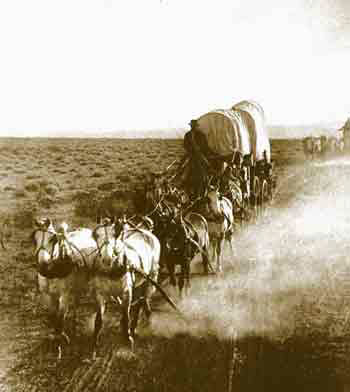Thousands of traders and homesteaders followed the
Santa Fe Trail from Independence, Missouri to Santa Fe, New Mexico, transporting
millions of dollars in goods. But the goods did not stay in Santa Fe.
Most were moved south over El Camino Real de Tierra Adentro (The Royal
Road of Interior Land) to Chihuahua City and central Mexico. The Santa
Fe Trail probably would not have existed without the Camino Real.
This ancient route dates back to prehistoric times when Indians from
the Aztec capital at Tenochtitlan, now Mexico City, followed this route
to northwestern Chihuahua. By 1540, Spanish miners, traders, missionaries,
soldiers and cattle drovers moved northward along the Camino Real.
In 1598, the conquistador, Juan de Oñnate, followed this route,
leading the first permanent European settlers into what is now the United
States. By 1609, the road ran from Mexico City to Santa Fe, carrying
trade items and new settlers.
In addition to being an immigration and trade route, the Camino Real
was also an invasion route. During the war between the United States
and Mexico, Colonel Alexander W. Doniphan led a small force of volunteers
from Missouri to capture Chihuahua City. At the Sacramento River, just
outside of Chihuahua City, this force defeated a much larger Mexican
unit. The battle site is marked by a monolith clearly visible from our
bus at the first toll booth out of Ciudad Chihuahua.
Doniphan's regiment occupied the city the next day, but evacuated it
shortly thereafter in order to join a larger American force to the east.
His group had then completed a march of well over 3,000 miles through
some of the worst weather and terrain conditions imaginable.
Trade continued after the war and a railroad was built linking El Paso
with Mexico City. Today, traveling along this route from Chihuahua to
El Paso, we see an occasional freight train, but there is no longer passenger
service. The Chihuahua al Pacifico Railroad, the famous Copper Canyon
train, is one of the few passenger services left in Mexico today.
One of my favorite times in leading groups through Copper Canyon is this
last day of our trip where we follow this historic route from Chihuahua
to El Paso. As our bus follows Mexican Highway 45, the travelers reminisce
about the wonderful experiences we have shared. The country is flat and
arid, so different from the rugged mountains and canyons of the Sierra
Madres which we have left behind us.
We pass few settlements along the way. El Sueco, named to honor a Swedish
settler who came here many years ago, and Villa Ahumada, named for a
general in the Mexican Revolution. We cross the border and travel to
the El Paso Airport, bidding farewell to our friends and to our Copper
Canyon journey.
Click Here for information on our Copper Canyon Tours.


 By
Don Fuchik
By
Don Fuchik
